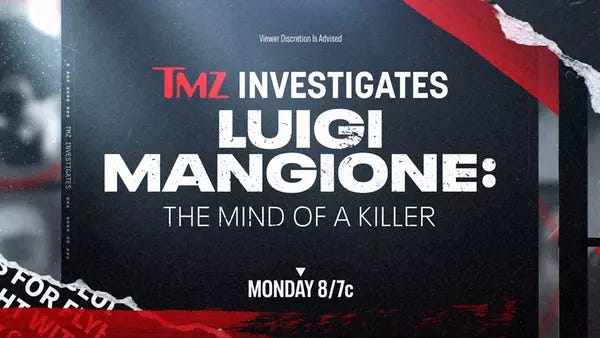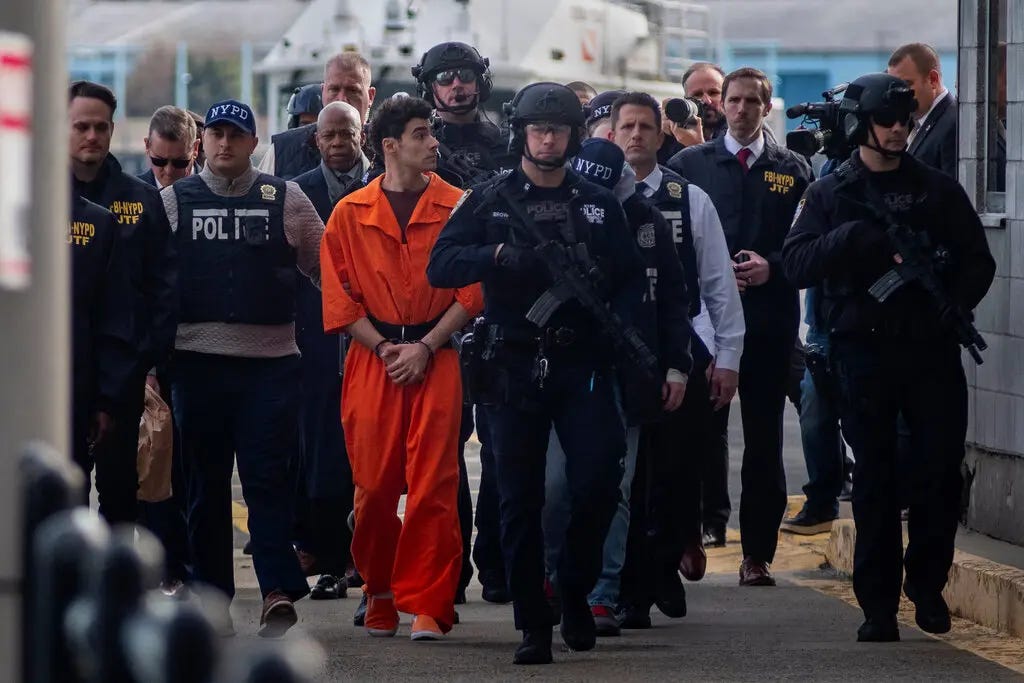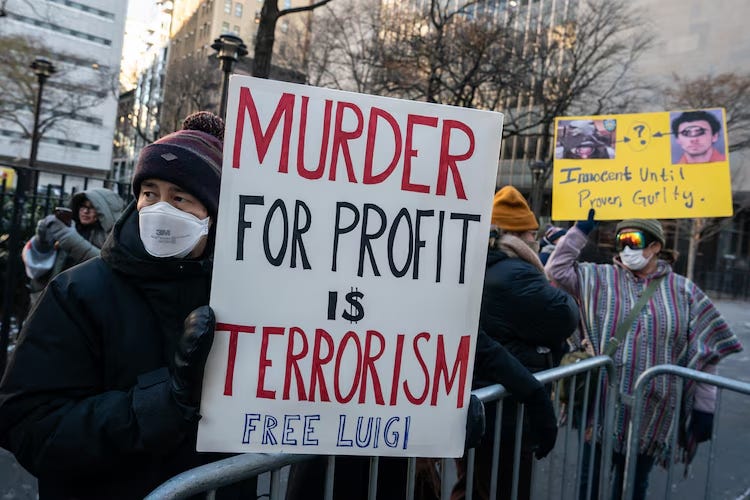The Price Luigi Mangione Pays
When Justice Becomes Entertainment and Spectacle Demands a Sacrifice
No introductions needed; we all know who he is: Luigi Mangione, a 26-year-old man accused of allegedly murdering a CEO of a health insurance company on December 4, 2024, in broad daylight. An atypical event compounded by an equally unusual profile—about which we will not speak until due process unfolds.
This case is not only relevant due to its unusual nature but also because of how it has been exploited to feed the machinery of media spectacle. Beyond the facts, what has taken center stage is how the public narrative has been built on speculation and testimonies of dubious credibility, blurring the line between truth and fiction.
This article aims to analyze the different dimensions of the case because, frankly, a massive amount of content has been generated that we believe fails to rise to the occasion.
The Construction of the Narrative
In just two months, we have witnessed how, at record speed, multiple documentaries have been produced and released about Luigi Mangione, a young man accused of murder and currently in preventive detention awaiting trial.
Are we surprised? Probably not, because this predatory attitude has defined the modus operandi of mass media for years. However, what should deeply concern us is the constant violation of one of the fundamental pillars of procedural law: the presumption of innocence. Before the trial has even taken place, narratives have already been manufactured, and public judgments have been made, distorting the perception of the case.

This media construction relies heavily on the appearance of "witnesses" whose connection to Mangione is, at best, tangential. People who exchanged a few messages with him or saw him briefly on video calls appear on screen claiming they knew him, offering subjective and often contradictory accounts. They are not seeking the truth because the truth can only be determined, if at all, through the trial. What they seek is relevance, to be part of the dominant narrative, and in some cases, to monetize their participation in the public story.
Even more troubling is the fact that many of these individuals have no real connection to the case. They present themselves as close friends, confidants, or witnesses to Mangione's personality when, in reality, they barely exchanged a few words with him. They sell out to the highest bidder for a paltry fee, for a few minutes of attention in a documentary that will probably be forgotten in a few months. Their role is that of mere pawns in a media machine that uses and discards them, but their irresponsibility has real consequences. They actively contribute to the distortion of facts, reinforce sensationalist narratives, and participate in the dehumanization of an accused person who, let's remember, has not yet been judged.
The impact of this phenomenon goes beyond constructing a distorted image of the accused. Media exposure directly affects the right to a fair trial. The information overload, often speculative or biased, can influence the jury's perception, create pressures on the prosecution and defense, and even affect legal strategies depending on how the story is presented to the public.
The business of true crime thrives on this morbid fascination with crime. Turning legal cases into entertainment generates millions in audience numbers and, consequently, enormous financial profits. Documentaries, podcasts, and articles appear in rapid succession with a clear goal: to exploit tragedy in real time without waiting for the legal process to do its job. This process of sensationalizing crime is not limited to the media; it also involves individuals who present themselves as "witnesses" without having professional expertise in the matter. Those who appear in the documentaries do not contribute relevant information but serve as narrative tools that add drama and fictional credibility to the story being constructed. And worst of all, they do it knowingly. They are not victims of a ruthless system but active participants in its degradation.
A Show of Government Force: Reinforcing the Narrative
The way his arrest and extradition were handled reinforces this perception. A clear example of the state's display of power was his perp walk following extradition, where he was surrounded by police officers armed with assault rifles in what seemed like a scene straight out of a high-budget antihero movie. This display of force was completely disproportionate, considering that we are talking about an individual with no history of violence, no problematic profile, and who, we dare say, poses no imminent danger to the general population.
The use of the perp walk as a media tool is not new. In the U.S. criminal justice system, this practice has historically been used to reinforce narratives of guilt even before a defendant has been tried. The image of a handcuffed suspect framed by a significant police presence creates a perception of dangerousness that influences public opinion and shapes how the case is perceived.
In Mangione's case, this theatricalization takes on particular significance when considering the nature of the crime he is accused of and his profile. The level of force employed during the arrest suggests that the authorities were not only seeking to ensure his detention but also to send a message. The fact that he was surrounded by agents armed with assault rifles—a type of weapon typically reserved for high-risk situations such as capturing terrorists or highly dangerous criminals—constitutes a symbolic act that goes beyond operational necessity. It is important to note that Mangione was neither a fugitive who had committed multiple murders nor an armed and dangerous individual at the time of his arrest. Yet the state decided to present him as such.
This type of staging serves several functions. First, it aims to consolidate the image of control by the authorities. In a context where crime and justice are central topics in public debate, these types of demonstrations serve to reinforce confidence in institutions and project the idea that the system is relentless with those who commit crimes, especially if they have generated significant media repercussions.
Second, this excess of force also carries a punitive component. By treating someone like Mangione—educated, with no criminal record, and with an atypical profile among homicide suspects—with the same level of force used for a dangerous criminal, the state seeks to send a clear message: no one who challenges the status quo is above the system, regardless of their status or background. It is an exercise in public humiliation that serves to reaffirm the authority of the judicial and police apparatus and likely to maintain the established order.
Moreover, this type of media spectacle also influences the development of the trial. The image of an accused person subjected to an excessive show of force helps shape the social perception of their dangerousness, which can impact the jury's opinion and ultimately the verdict. Although the U.S. judicial system is theoretically based on the presumption of innocence, in practice, such spectacles erode that presumption and reinforce the idea that the accused has already been convicted in the court of public opinion.
Social Implications of Supporting Luigi Mangione
One of the most striking aspects of the case has been the significant online support Mangione has received, with donations reaching $300,000 for his legal defense through a GiveSendGo campaign. However, the press has treated this phenomenon with a sensationalist approach, using terms such as "sick donors" or "fans," distorting the nature of these contributions and oversimplifying a phenomenon that is actually much more complex.
The reality is that this support cannot be reduced to a matter of hybristophilia or morbid fascination. For many, the narrative surrounding the case has generated a perception of procedural injustice or disproportionate media treatment. Additionally, the sociopolitical context surrounding the crime has played a key role in how many people perceive the case.
Mangione is accused of murdering a CEO of a health insurance company, an industry synonymous in the U.S. with exclusion, relentless bureaucracy, and, in many cases, human suffering. The healthcare system in the U.S. is a multi-billion-dollar business based on privatization and risk management, meaning that insurers have the power to decide which treatments are covered and which are not, often with devastating consequences for patients. The consequences of denials of coverage, exorbitant drug prices, and families facing financial bankruptcy due to unpaid medical bills are a reality for many in the U.S.
In this context, it is not surprising that Mangione's case has garnered significant support from sectors that have been victims of this system. For many, his accusation is inevitably linked to a widespread resentment toward insurers, seen as institutions that prioritize profits over human life. His alleged act, regardless of guilt or innocence, has been interpreted by some as an extreme manifestation of collective frustration with a system that has failed millions of citizens.

On the other hand, there is a second group of people who firmly believe in his innocence and consider that he has been unjustly framed. Due to the erosion of credibility that certain state institutions are experiencing, the lack of clear information, the speed with which narratives have been constructed in the media, and the use of his personal history to fabricate a criminal profile have created a perception of arbitrariness in the process. From this perspective, raising funds for his legal defense is not just an act of support but a form of resistance against what is perceived as a judicial and media machine predisposed against him.
Conclusion
The case of Luigi Mangione transcends its strictly judicial dimension to become a mirror of the current tensions between justice, media, and social perception. The sensationalization of the process, with rushed documentaries and manipulated narratives, not only jeopardizes the right to a fair trial but also reflects a perverse dynamic where crime becomes a mass consumption product.
The theatricalization of punishment by the state, evidenced in his perp walk, underscores how the judicial system not only seeks to dispense justice but also to project power and control through carefully calculated images. In this context, it is troubling how the media and state institutions seem to negatively reinforce each other: the former amplify narratives that benefit spectacle, while the latter take advantage to strengthen their image as implacable authorities.
The social support for Mangione also highlights a fracture in trust toward institutions such as health insurers, turning his figure into a symbol of resistance for some sectors.
This case raises disturbing questions: To what extent should the media inform without becoming mediatic judges? What are the implications of the theatricalization of justice for fundamental rights? And above all, what does this case say about us as a society?
Beyond Mangione's guilt or innocence, what is at stake is the preservation of a judicial system based on fairness, truth, and due process. As a society, we must reflect on the role we play in this narrative, demanding not just justice but also accountability in how stories of crime and punishment are constructed and consumed.
And please, be careful with symbols that are not self-proclaimed, because they are the ones who pay the final price.
And it’s a very high one.





